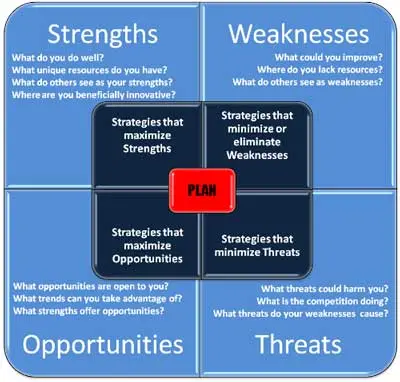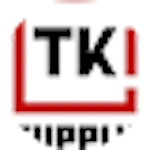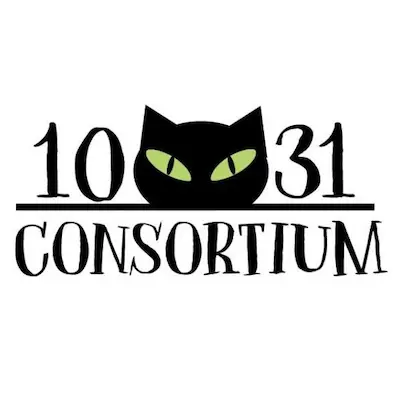
SWOT stands for Strengths, Weaknesses, Opportunities, and Threats. Identifying your construction firm’s strengths, weaknesses, opportunities, and threats could mean the difference between your company’s success and failure.
By correctly conducting a Construction SWOT analysis, you can identify where you succeed and where you need improvement. You can adapt your methods to help meet your goals, serve your target market, and carve out your market share in your niche.
Protip: Content marketing and awesome construction company websites are easy, affordable, and efficient ways to do this. If your company doesn’t have a website, check out our pay-per-month website program to help avoid resource-draining website development costs.
Related Articles:
- 10 free marketing tools you can use for your construction company
- How to create a marketing plan for your construction company
- 10 Step Business Strategy for Your Baton Rouge Company
- Best Affordable Websites for Contractors
- Websites for Plumbing Companies
- Websites for Architectural Firms
- Digital Marketing for Plumbers: 8 Strategies to Grow your Business
Although this article is specifically for construction companies and contractors, you can easily modify this model for any small (or enterprise) business.
Here’s an overview of what a SWOT Analysis for a business is:
Ready? Set. Let’s Go; it’s time for you to learn all about a swot analysis for a construction company.
So what would our community look like without construction companies?
Construction companies are a critical component of any community.
Take Denham Springs, Louisiana, for instance, where construction is booming.

These companies build our homes, they repair our streets, they create sidewalks for us to walk on, they repair existing sidewalks, and more.
We all know that you can’t travel from point A to point B anywhere in Louisiana without encountering traffic generated by a road construction crew.
Clearly, the construction industry was highly needed in 2020. But a need doesn’t necessarily guarantee financial growth.
For any business (irrespective of size), a few poor decisions can destroy a flourishing construction company.
But, by performing a SWOT analysis, you can see what possible poor decisions are on the horizon and identify benefits that other players in the construction industry may ignore.
After reading this article, hopefully, you’ll be able to clearly see the key differences between a successful construction business and a failed one.
Construction Company Strengths
Every construction company builds something.
The mission of a construction company is to construct what the client wants.
Whether your construction company is building a new apartment complex, a segment of a road, or a new school, your business is unique.
Examples of Construction Company Strengths
Here are some examples of strengths that your construction company may have:
Efficiency
- Efficiency reduces expenses.
- It improves profits.
- It can mean the difference between a three-year project versus a one-year project.
- Missing even one deadline is all it takes for a company to lose its good standing with a customer.
- Clients are more likely to hire a company that’s mindful of deadlines and aims to complete their projects in a suitable time frame.
- Of course, without sacrificing the quality and safety of their employees.
- Meeting deadlines depends on strong project management skills.
- Successful construction companies rely heavily on project managers to oversee their projects.
- Without an expert’s eyes and ears on the project, most will fail.
- Many companies outside the construction industry need to focus on a particular niche.
- Construction companies are lucky because they’re the opposite; they thrive by working with multiple industries simultaneously.
Experience / Skills
Whether you’re a new player in the construction industry or you have been in business for years, you have some sort of experience in your field.
Through your experience, you have workers who have already worked on construction projects of varying sizes and scopes.
Customer Service
By having you and your team members provide excellent customer service, you can easily control this strength.
Working Relationship with Material Suppliers
You have your go-to suppliers for the materials that it takes to complete your project.
You know the quality of their products already and can make sure your clients get the best bang for their buck.
Knowledge of your Subcontractors
On previous projects, you’ve done business with your subs and have established good relations with them.
When you know what to expect of the subcontractors, it makes your project planning go much easier.
These are just a few of the types of strengths you can discover in your construction company’s SWOT analysis.
Construction Company Weaknesses
As much as you may not want to believe it, yes, your construction company does have its’ share of weaknesses.
That’s OK; that’s what a SWOT analysis is for.
Examples of Construction Company Weaknesses

Inexperienced Workers
Perhaps you’re a new player in the construction business, and your workers lack the experience that your competitors have.
Don’t worry; you’re not alone.
92% of contractors report being at least moderately concerned about their workers having adequate skill levels. [USG + U.S. Chamber of Commerce]
Perhaps you are faced with a challenge on a project requiring you to use a building method you’re not familiar with.
Maybe you have some workers who have been in the industry for decades who have their own ways of doing things and are slow to embrace technology or new methods.
Or, perhaps you don’t have the cash flow to purchase new tools and equipment needed to embrace new technological advances in construction.
Resistance to New Construction Methods and Technology

Construction Company Opportunities
Construction companies should always be on the lookout for more clients and should either recognize their current opportunities. If there are no opportunities, you’ve got to make them.
Examples of Construction Company Opportunities
Possibilities of Working on Future Projects
When a contractor wins their client’s trust, they will be more likely to partner on new projects in the future.
At high trust companies, 4 out of 5 projects are for repeat customers, potentially increasing gross margins by 2-7% [Autodesk + FMI]
Knowledge of Developing Trends
Perhaps you’re one of those innovative and tech-savvy companies that keeps up with trends in the construction industry.
You’ll be ready to take on new projects that utilize new and more efficient design methods.
Or, perhaps you notice an uptick in residential construction in an area. You can leverage that knowledge to shift your business.
Construction Company Threats
Threats aren’t always controllable, especially in construction.
There are things that you just can’t control that vary from anything from environmental variables to human behavior.
The only thing that you can do is utilize strategic planning to address those threats and be prepared to react to them.
Your Strengths and Opportunities are where you make your money!
Examples of Construction Company Threats
Although this list isn’t all-inclusive, some examples of construction company threats include:
Inclement Weather
If you live in South Louisiana, this threat needs no explanation. From the rainy season to hurricane season, weather can wreck a construction project and affect deadlines.
Quarantine
This is a relatively new threat, and although it seems to have popped up all of a sudden, there was actually some advance warning.
Construction companies could have (and perhaps did) take note of the COVID-19 effects in other countries and prepared for the possibilities of a pandemic here in the United States.
Economical Factors
Although your construction company can’t prevent a recession, it’s possible that you can see one coming.
By identifying economical threats, your company can be better prepared to shift assets or workers to soften the blow created by an economic downturn.
Conclusion
Performing a SWOT analysis for your construction company is critical.
By identifying your Strengths, Weaknesses, Opportunities, and Threats, you can have an adequate assessment of where you stand, what you need to improve to, where you have room to grow, and internal and external factors that could hinder your success and create failure.















































